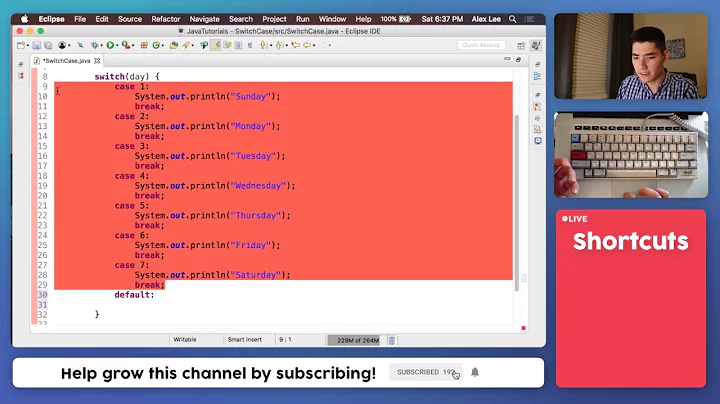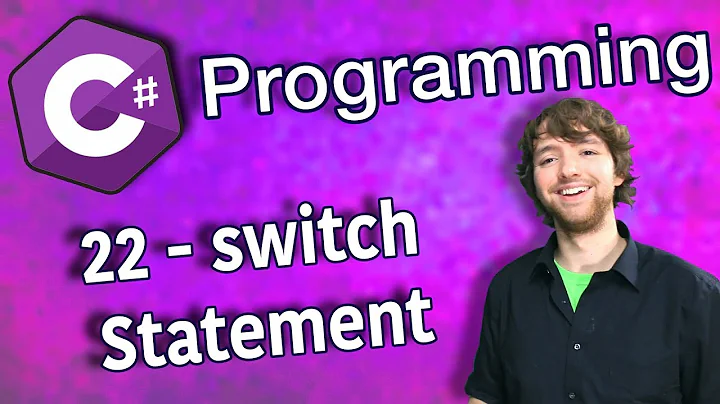Large Switch statements: Bad OOP?
Solution 1
You may get some benefit out of a Command Pattern.
For OOP, you may be able to collapse several similar commands each into a single class, if the behavior variations are small enough, to avoid a complete class explosion (yeah, I can hear the OOP gurus shrieking about that already). However, if the system is already OOP, and each of the 100+ commands is truly unique, then just make them unique classes and take advantage of inheritance to consolidate the common stuff.
If the system is not OOP, then I wouldn't add OOP just for this... you can easily use the Command Pattern with a simple dictionary lookup and function pointers, or even dynamically generated function calls based on the command name, depending on the language. Then you can just group logically associated functions into libraries that represent a collection of similar commands to achieve manageable separation. I don't know if there's a good term for this kind of implementation... I always think of it as a "dispatcher" style, based on the MVC-approach to handling URLs.
Solution 2
I see having two switch statements as a symptom of non-OO design, where the switch-on-enum-type might be replaced with multiple types which provide different implementations of an abstract interface; for example, the following ...
switch (eFoo)
{
case Foo.This:
eatThis();
break;
case Foo.That:
eatThat();
break;
}
switch (eFoo)
{
case Foo.This:
drinkThis();
break;
case Foo.That:
drinkThat();
break;
}
... should perhaps be rewritten to as ...
IAbstract
{
void eat();
void drink();
}
class This : IAbstract
{
void eat() { ... }
void drink() { ... }
}
class That : IAbstract
{
void eat() { ... }
void drink() { ... }
}
However, one switch statement isn't imo such a strong indicator that the switch statement ought to be replaced with something else.
Solution 3
The command can be one of 100 different commands
If you need to do one out of 100 different things, you can't avoid having a 100-way branch. You can encode it in control flow (switch, if-elseif^100) or in data (a 100-element map from string to command/factory/strategy). But it will be there.
You can try to isolate the outcome of the 100-way branch from things that don't need to know that outcome. Maybe just 100 different methods is fine; there's no need to invent objects you don't need if that makes the code unwieldy.
Solution 4
I think this is one of the few cases where large switches are the best answer unless some other solution presents itself.
Solution 5
I see the strategy pattern. If I have 100 different strategies...so be it. The giant switch statement is ugly. Are all the Commands valid classnames? If so, just use the command names as class names and create the strategy object with Activator.CreateInstance.
Related videos on Youtube
Erik Funkenbusch
Senior Software Developer with extensive experience in Microsoft and other technologies http://www.scoop.it/u/erik-funkenbusch
Updated on July 05, 2022Comments
-
Erik Funkenbusch almost 2 years
I've always been of the opinion that large switch statements are a symptom of bad OOP design. In the past, I've read articles that discuss this topic and they have provided altnerative OOP based approaches, typically based on polymorphism to instantiate the right object to handle the case.
I'm now in a situation that has a monsterous switch statement based on a stream of data from a TCP socket in which the protocol consists of basically newline terminated command, followed by lines of data, followed by an end marker. The command can be one of 100 different commands, so I'd like to find a way to reduce this monster switch statement to something more manageable.
I've done some googling to find the solutions I recall, but sadly, Google has become a wasteland of irrelevant results for many kinds of queries these days.
Are there any patterns for this sort of problem? Any suggestions on possible implementations?
One thought I had was to use a dictionary lookup, matching the command text to the object type to instantiate. This has the nice advantage of merely creating a new object and inserting a new command/type in the table for any new commands.
However, this also has the problem of type explosion. I now need 100 new classes, plus I have to find a way to interface them cleanly to the data model. Is the "one true switch statement" really the way to go?
I'd appreciate your thoughts, opinions, or comments.
-
creator over 7 yearsHow about use expression? So find the function by its name and call it. Name can be easily match with passed variables, so then we don't need to use switch.
-
-
jcopenha over 15 yearsAgree with dictionary and delegate idea. You will probably also get a performance improvement using Dictionary<string,Action> over a big switch statement. The difficulty is in initializing it, though this can be automated using reflection if desired.
-
davogones over 15 yearsPerhaps the initialization could be pulled from configuration.
-
oz10 over 15 yearsI'm curious what compiler implements switch statements of strings using perfect hashing?
-
causa prima over 15 yearsThe problem is that this data is coming from elsewhere, it can't be object oriented as it comes in. Something needs to be done to convert it to object orientation and generally that's a large switch.
-
 Admin over 15 yearsThe problem is that you don't know if you receive a This or a That command over the network. Somewhere you have to decide whether to call new This() or new That(). After that abstracting with OO is a piece of cake.
Admin over 15 yearsThe problem is that you don't know if you receive a This or a That command over the network. Somewhere you have to decide whether to call new This() or new That(). After that abstracting with OO is a piece of cake. -
 Admin over 15 yearsThe problem with reflection is that many web hosts runs in a trust-level that don't allow you to use it :(
Admin over 15 yearsThe problem with reflection is that many web hosts runs in a trust-level that don't allow you to use it :( -
Thedric Walker over 15 yearsInterestingly enough if the only difference between the branches is that they are different subclasses of a base then you are basically describing a factory.
-
 Admin almost 11 years+1. I get disheartened hearing folks complain about switches being smelly, but then suggest an alternative that is really just abstracted switch behavior smeared out across the entire system, as opposed to a neat stack.
Admin almost 11 years+1. I get disheartened hearing folks complain about switches being smelly, but then suggest an alternative that is really just abstracted switch behavior smeared out across the entire system, as opposed to a neat stack. -
Jonas Kölker almost 11 years"a map [can be O(1)]" -- if the lookup reads k bits, it can distinguish between 2**k different keys. Thus, for n keys, you need to read at least log(n) bits. How can you do that in O(1) time when log(n) is unbounded? In which model?
-
quamrana almost 11 years@JonasKölker: A map can be implemented with a hash table which can find the correct key with
O(1). See this answer: stackoverflow.com/a/1055261/4834 -
C. A. McCann almost 11 yearsThe hash function still has to process those log(n) bits. Hash tables (and some kinds of lookup tree) are O(1) with respect to values contained, but O(n) or worse with respect to the bit size of key values.
-
gnasher729 over 10 yearsAny decent compiler uses a table for switch statements with consecutive case values, or a binary decision tree where this doesn't work or where based on the good knowledge of the processor architecture the binary decision tree is faster. For case statements with many values that are far apart, a good compiler will hash the value to reduce it to a table if that is beneficial. No matter what, the compiler will use the strategy that implements the switch statement in the fastest possible way. So excuse me, but refusing a switch statement for performance reasons is stupid.
-
Cam Jackson over 10 yearsThis might be pedantic, but is a map (string->command) really a branch? Conceptually it might be, in that there are multiple things that might happen depending on the value of a variable, but when I think of branching I think of something that explicitly checks a variable for possible values. Whereas a map is a direct lookup. In other words, the association of condition to result is done once at the start (at map population) rather than every time (by testing the variable). Under that definition, the map of commands does remove the branch.
-
Jonas Kölker over 10 years@CamJackson: Sure, if you use a map you can use it with code that doesn't do any branching itself---it has outsourced the branching to whatever
map_lookupfunction it calls (which will branch). I'm not sure what that observation buys you. "It's not really a branch if it happens elsewhere"? The association between input and output is done at compile time for switch (and other control flow) statements, and at run-time for data structures (most likely). It's not like the shape of the switch changes at run-time. Both kinds of look-up require (and one is) a branch. I hope that helps :-) -
Cam Jackson over 10 years@JonasKölker That's a good point. I guess I didn't think carefully about the actual data structure and how it works. So the only real way to remove the branch would be if your 100 commands conveniently happened to be called 0, 1, 2, etc, so that you could use them as indices directly.
-
Jonas Kölker over 10 years@CamJackson: I think I agree---in that case, the only branching that will happen is due to the fact that what is stored in your 100-element array will be put into the program counter (in java this happens indirectly and behind the scenes). Here, I define branching to mean that after the program counter assumes one particular value, it can assume multiple different next values (under normal program execution, no cosmic rays). (Total nitpicking: if your commands were named 0..17 and 19..100, you could have an 101-element array A where A[18] is an error handler. You can generalize further.)
-
Erik Funkenbusch almost 10 yearsThat's simply not true. Switch statements use a jump table, so it takes no longer to switch on 2 items as it does on 2000. It's a single table lookup.
-
 Robert Achmann almost 10 yearsEven when the switch statement compares on string values?
Robert Achmann almost 10 yearsEven when the switch statement compares on string values? -
Erik Funkenbusch almost 10 yearsWell, obviously it depends on the length of the string value, but other than that, yes. Windows uses C, which can't switch on strings anyways, but in C# you can. It's still a lookup table.














